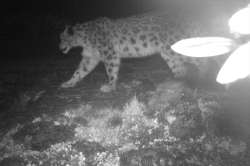In a first, elusive snow leopard spotted in Arunachal Pradesh
In a first, photo evidence confirms the presence of elusive feline snow leopard in the high altitude region of Arunachal Pradesh at 3,900 metres above sea level.

In a first, photo evidence confirms the presence of elusive feline snow leopard in the high altitude region of Arunachal Pradesh at 3,900 metres above sea level.
The endangered species are widely spotted in the High Asian region, especially in Jammu and Kashmir's Ladakh region in India. Due to their elusive nature, very less is known about them, and their population has been estimated at between 3,920 and 6,390 globally.
The World Wide Fund for Nature (WWF)-India's recent study yielded photo evidence of snow leopards in Arunachal Pradesh -- a state that is resplendent with biodiversity and yet largely unexplored.
"The species was photographed at an altitude of 3,900 metres above the sea level," a WWF-India official told IANS.
It was photographed by a camera trap set up at Thembang, one of the Community Conserved Areas in the state.
According to WWF-India, the evidence is particularly significant, more so given that large natural areas in Arunachal Pradesh fall under the custodianship of local communities whose support is crucial for protecting the species and its habitat.
So far, only a fraction of snow leopard habitat in the state falls in the two protected areas -- Dibang Biosphere Reserve and Namdapha National Park.
The presence of the big cat beyond these protected areas highlights the importance of community support for conservation as well as landscape scale conservation planning.
The state-wide survey carried out by WWF-India in collaboration with the Arunachal Pradesh Forest Department was conducted from March 2017, focusing on the unexplored areas.
"This perhaps is the first time that the presence of snow leopard has been reported through a camera trap photograph from the state of Arunachal Pradesh," said Omkar Singh, PCCF & Principal Secretary, Department of Environment and Forest, Arunachal Pradesh.
"The findings of this survey will help in developing conservation plans for the iconic species of the region."
Further, the researchers also interviewed the local communities, herders and former hunters who provided detailed information on snow leopards across the state as well as its prey species.
"Over 80 per cent of the interviewees confirmed the presence of snow leopards in their area, an encouraging sign for the state," a WWF-India statement said.
The survey is significant as it covers one of the 22 priority landscapes of the Global Snow Leopard Ecosystem Protection Program.
The findings will enable the state Forest Department to develop a snow leopard conservation plan to address increasing threats such as retaliatory killings, infrastructure development and climate change induced impacts on the habitats.
"This ambitious survey has enhanced our knowledge on the distribution of snow leopards and its prey species for the entire state of Arunachal Pradesh which will be of immense help in the better conservation-management of the species," said Rishi Kumar Sharma, Senior Coordinator, Species and Landscapes Programme, WWF-India.
